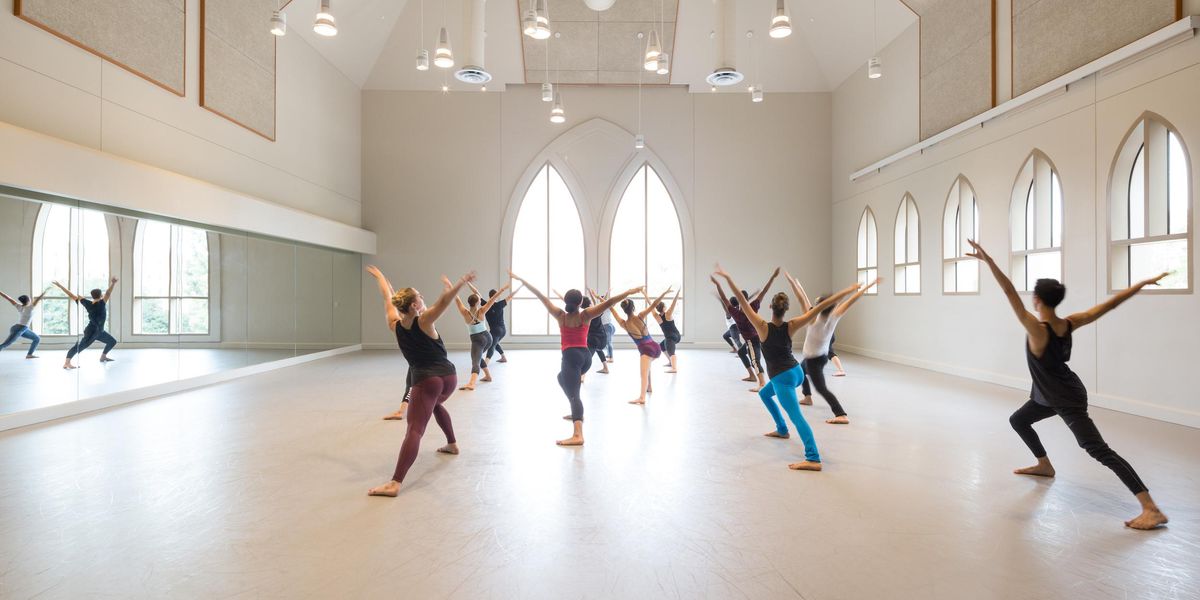Still Unstoppable
Lecavalier with Robert Abubo in her latest creation, Battleground. PC André Cornellier, Courtesy Fou Glorieux.
At 57, Louise Lecavalier has reinvented herself—without losing the daredevil energy audiences love her for.
Louise Lecavalier does not so much dance as combust. It can be a slow burn of small, scampering steps complemented by fluttering arms or complex hand gestures. Then it suddenly blazes into fast, furious, frenetic explosions of energy. The intensity can be almost unbearable.
At age 57, Lecavalier is once again soaring across the dance world like a comet, almost two decades after quitting the company that made her famous. Mother to 14-year-old twin girls, loaded with awards and honors, she is now an independent dancer/choreographer and director of her own production company, called Fou Glorieux.
So Blue, her first major choreographic endeavour, is now in its fourth year of international touring. Meanwhile, her latest creation, Battleground, is already booked well into next year.
Lecavalier began her dance training in high school, then apprenticed with Le Groupe Nouvelle Aire, an experimental Montreal troupe. There she met Édouard Lock. In 1981, he invited her to join the company he’d recently founded, what would become La La La Human Steps. So began a fruitful relationship between Lock as choreographer and Lecavalier as his muse. Her spectacular double horizontal barrel turns became emblematic of a new wave of contemporary dance, testing the extremes of speed, precision and hyper-physicality. With her pyrotechnic virtuosity, she was a proud emblem of female strength and physical daring.
She also became contemporary dance’s closest equivalent to a pop star. Lecavalier danced with David Bowie, collaborated with Frank Zappa and appeared in films, such as Kathryn Bigelow’s 1995 sci-fi thriller,
Strange Days. Adoring fans trailed Lecavalier as she walked the streets on foreign tours. But she didn’t let fame faze her. “I was not so aware of being the star,” she says. “I didn’t think about that because it might freak me out. I like to have fun dancing.”
Yet in the early 1990s, Lock began shifting his troupe’s artistic identity to a more controlled, structured, even balletic, aesthetic. In 1998, with Exaucé (billed in English as Salt), Lock put the cast’s women on pointe—all except Lecavalier. Her brief thunderbolt appearances looked more like obligatory star turns than integral parts of Lock’s overall choreographic design.
The next year, Lecavalier, then 40, decided to leave. As she explains, it wasn’t just because of a chronic hip injury. (She had been managing that for several years.) She no longer felt there was a place for her there. “Édouard’s style was changing,” says Lecavalier. “La La La was becoming more of a ballet company.”
She had no specific plans other than to take a much-needed break. But Canadian choreographer Tedd Robinson, a longtime fan, lured her back to the stage. “When I think of Louise’s days with Lock, it’s her eyes I most remember,” says Robinson. “The way she would look out at the audience. There was a ferocity and mischievousness, a spark of defiance, independence and excited energy. She always projected this strong feminine persona.”
As Robinson approached his 50th birthday, he conceived a plan to choreograph a program of three duets, each featuring him and one of his favorite dancers. Lecavalier was on his dream list along with another celebrated Canadian, Margie Gillis, and Japan’s critically acclaimed Mako Kawano. He judiciously adopted a low-pressure approach, and Lecavalier responded by suggesting they hang out in the studio and try a few things before committing to the piece.
“It was a pleasure working in the studio again with no pressure,” Lecavalier recalls. The result was
Lula and the Sailor, first performed by Lecavalier and Robinson in 2003, but at a cost: The pain in her damaged right hip became unbearable. “I got through on adrenaline,” she admits.
With her appetite for dance restored, she moved ahead with surgery to resurface the joint. “It gave me a second life,” says Lecavalier.
And what a second life!
Lecavalier launched into a series of collaborations, working with choreographers, like Benoît Lachambre and Crystal Pite, who shared her personal belief in the centrality of the body and the hidden impulses that animate it. She founded her Fou Glorieux in 2006 to provide an institutional framework for her projects, commissioning choreographers and, as required, other dancers. Yet her name, rather than the company’s, remains the marquee audience magnet.
“Many people worldwide still associate Louise with La La La, but she has reinvented herself as a unique artist,” says Cathy Levy, the National Arts Centre’s dance producer. “We can see where she comes from, and how the extremes she found in her movement helped define Édouard’s style, but we can also see where she is going as she reaches new heights with her movement style of today.”
Lecavalier’s vocabulary still includes her famous bursts of frenetic energy, but her various post–La La La collaborations have allowed her to discover the pleasure and power of moving slowly. She jokes that it’s the stuff in between that doesn’t appeal to her.
This more measured approach could be seen as an inevitable capitulation to age, but Lecavalier insists its basis is always artistic, a reflection of her own continuing exploration of movement possibilities. “You can’t think about pacing yourself when you’re creating something,” she says. “Ideas bring ideas and the body is changing all the time. I push myself because it’s the way I live. I’m still passionate, extreme, transported.”
As she reflects on her ever-evolving career, Lecavalier offers a personal credo: “Dance helps me become myself. I want the body to say everything it wants to say without censoring it, hoping that it might point to new paths, new ways of getting to the essential core of things.”
Michael Crabb is a senior advising editor for
Dance Magazine.




